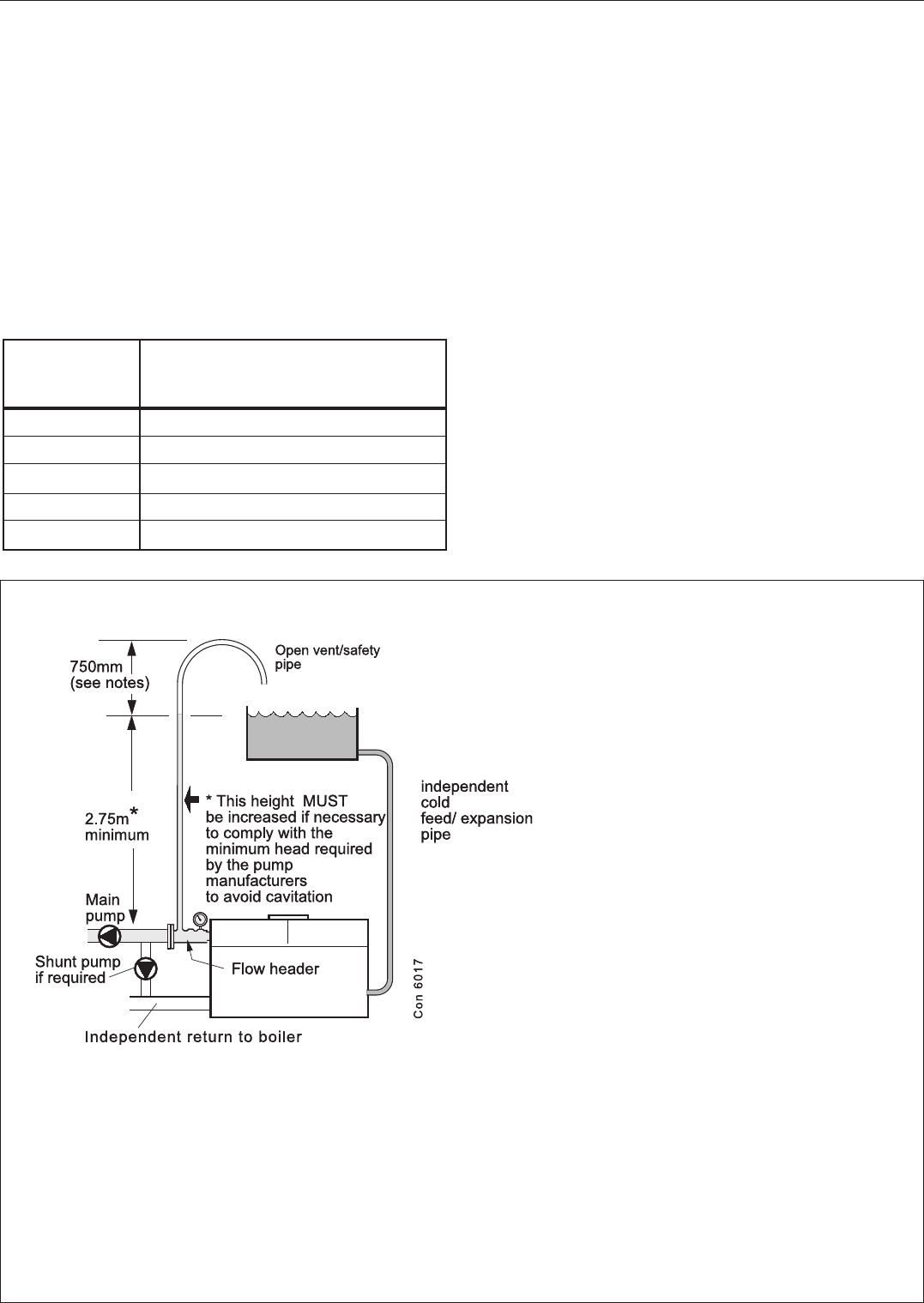
GENERAL
7
Concord CXSi/H - Installation & Servicing
Note. This diagram does not show safety valves, water flow
switches, etc., necessary for the safe operation of the system.
3
OPEN VENTED SYSTEMS - minimum static head requirements
Particular reference should be made to BS. 6644: Section 2; Subsection
10 and Guidance note PM5 "Automatically controlled steam and hot
water boilers" published by the Health and Safety Executive.
The information and guidance given below is not intended to override any
requirements of either of the above publications or the requirements of
the local authority, gas or water undertakings.
Other British Standards applicable are BS.5422 and BS.6700.
The information provided is based on the
following assumptions:
1. The open vent MUST be brought to either
the 1
1/2" BSP tapping on the flow header
provided or to the unused 2" BSP flow
tapping at the top rear of the boiler.
2. An independent cold feed/expansion pipe
connection is made to the LH lower front
connection. Cold feed/expansion pipe
connections made to the pumped system
return will result in an increase in the static
head requirement, caused by the
additional resistance of the distributor tube.
Surging may also increase.
3. The maximum flow rate through the boiler
is based on a temperature difference of
11°C at full boiler output and the circulating
pump is positioned in the flow to the
system.
4. The boiler is at the highest point of
circulation in the system. Systems
designed to rise above the boiler flow
tappings will automatically require a
minimum static head higher than that
shown.
5. The position of the open vent/safety pipe
above the expansion cistern water level is
given as a guide only. The final position will
depend upon the particular characteristics
of the system. Pumping over of water into
the expansion cistern must be avoided.
WATER TREATMENT FOR HOT WATER AND
HEATING BOILERS
There is a basic need to treat the water contained in all heating and
indirect water systems, particularly open vented systems. It is
assumed, incorrectly, that because boilers are operating in
conjunction with what is apparently a closed circuit an open vented
system will not, under normal circumstances, allow damage or loss
of efficiency due to hardness salts and corrosion once the initial
charge of water has been heated up a few times.
1mm of lime reduces the heat transfer from metal to water by 10%.
In practice the deposition of these salts is liable to cause noises
from the boiler body or even premature boiler failure. Corrosion
and the formation of black iron oxide sludge will ultimately result in
premature radiator failure.
Open vented systems are not completely sealed from the
atmosphere if proper venting and expansion of system water is to
be achieved. The same tank is used to fill the system with water
and it is through the cold feed pipe that system water expands into
the tank when the boiler passes heat into the system. Conversely,
when the system cools, water previously expanded is drawn back
from the tank into the system, together with a quantity of dissolved
oxygen.
Even if leakage from the heating and hot water system is eliminated
there will be evaporation losses from the surface of the tank which,
depending upon ambient temperature, may be high enough to
Table 4 - Flow rates for fully pumped systems
Boiler Minimum flow rates for a
temperature difference of 35°C (63°F)
l/s g.p.m.
CXSi 110/H 0.75 9.9
CXSi 120/H 0.82 10.8
CXSi 140/H 0.96 12.7
CXSi 160/H 1.10 14.6
CXSi 180/H 1.24 16.4
PUMP POSITIONS
Whenever practically possible the circulating pump(s) should be
positioned so that it pressurises the system being served. The
vertical distance between the pump(s) and any cold feed and
expansion cistern MUST comply with the pump manufacturers
requirements, in order to avoid cavitation. These requirements
override the information given in Frame 3 if the static head required
for the pump(s) exceeds that required for the boiler.
MINIMUM FLOW OF WATER - Refer to Table 4
The system design must provide for an adequate flow rate through
the boiler at all times when the boiler is firing. The minimum flow
rate should correspond to a temperature difference across the boiler
flow and return of 35°C (63°F), assessed at catalogue rating.
157294-3.pmd 11/8/2005, 9:58 AM7


















